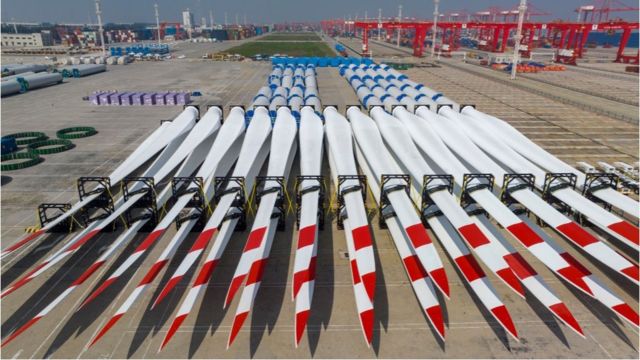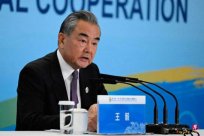October 17, 2023

Putin arrived in China to participate in the summit.
The Third Belt and Road International Cooperation Summit Forum will open on October 18. This year is also the tenth year of Chinese President Xi Jinping's proposal to propose the Belt and Road Initiative.
This ambitious plan has ushered in praise and controversy over the past decade.In May 2017, the first Belt and Road Forum was held. Two years later, in April 2019, the second forum was held.China seems to be ready to normalize the two -year forum, and then the epidemic strikes.
By June 2021, China was in the strictest period of epidemic prevention measures. It did not organize any face -to -face international conference or activities. Instead, he chose to organize a virtual Belt and Road summit with remote video, and the country was also limited.
After China's release this year, the daily life returned to normal. At the beginning of this year, then the then Foreign Minister Qin Gang mentioned that this year's two major home diplomacy MDASH; MDASH; China+Central Asian Heads Summit and the Belt and Road International Cooperation Summit Forum.
The reporter sorted out the three main points of the summit to help readers understand the event more deeply.
Who comes, who doesn't come?
China has not disclosed the number of heads of state and government of the visiting heads of the visit.
The Chinese government has not announced how many national heads of state or government will come to China Council. They only said that representatives of more than 130 countries and international organizations have signed up.
At the first summit of 2017, 29 foreign heads of state or government came to China, and in 2019 increased to 36.Considering that this year is the first and after the 10th anniversary of the Belt and Road Initiative, for China, it will undoubtedly want to surpass the first two sessions.
Chim Lee, an analyst at Economist Think Tank (EIU), told reporters that world leaders attending the summit may be less than previous summits.The Ukrainian war will affect the relationship between China and Eastern European countries, and the region may decline in leaders in the region; and Palestine's conflict will also affect the number of attendees of leaders in the Middle East.
The participation of European countries has declined as a whole.The first proportion will reach one -third, and the second then will decrease slightly.In the past four years, the overall relations between China and European countries have declined, and the re -election of Czech Republic and Italy and other countries have also changed their attitude towards the Belt and Road.
At present, the European leaders who can confirm the participating in the meeting include Hungarian Prime Minister Victor, and Serbian President Wugic.
It is worth noting that at the first two summits, the leaders of Africa and the Middle East accounted for little proportion, but these countries participated in the Belt and Road Initiative.It is expected that more leaders from these two regions will attend the meeting this year. At present, it is known that Ethiopian Prime Minister, Pakistani Government Prime Minister, Kenya President, Egyptian Prime Minister, etc.
However, it is worth mentioning that many national leaders, including Crown Prince Kuwait's prince and Syrian President, have come to China on September 23 to participate in the Asian Games. Whether it will visit China again in a short time is worth paying attention to.
More topical visits include representatives of Russian President Vladimir Putin and Afghan Taliban government representatives.
For Russia, this is the first time that President President Putin ordered military invasion of Ukraine and was arrested by the International Criminal Court for war crimes has visited the world's major powers (he has previously visited Kyrgyzstan).
For Afghanistan, since the re -capture of the regime, the Taliban government has not yet been recognized by any government. This summit will be a chance to show up in international activities.
Reuters quoted its internal members that it might discuss the construction of a plan that crosses the Wahan Corridor. The corridor is a mountain area in northern Afghanistan and is adjacent to China.
What is the problem of debt problems after the epidemic?
For some countries that have participated in the Belt and Road Initiative, there are also important tasks MDash; MDash; debt negotiations.
After the epidemic, the international economy turned, and the developing countries were even more, and the pressure on debt increased sharply;
Coupled with the significant interest rate hike of the Fed, the cost of financing has increased;
Finally, the fiscal management system of some countries is lacking.
For example, Laos, the Chinese -Laos Railway cost $ 5.9 billion, accounting for about one -third of Laos's economic aggregate.60%of the funds come from loans from import and export banks in China, and the remaining 40%of them are converted into project shares. Laos needs to invest $ 730 million in equivalent cash (of which 480 million US dollars are loans from Chinese import and export banks).
Laos will bear a total of more than $ 1.4 billion in debt.The country's GDP is less than $ 20 billion.
Potassium fertilizer minerals are one of the few sources of profit in Laos, and their income will be used to support this huge loan.By September 2020, Laos on the edge of bankruptcy sold an important asset to China to hand over some energy networks at a price of $ 600 million to seek the debt reduction and exemption of Chinese creditors.And all this happened before the railway started operation.
How to conduct debt negotiations is the primary consideration of these participants.Furthermore, China is also different from four years ago. The domestic economic pressure is getting bigger and bigger mdash; mdash;
Supporters believe that the Belt and Road Initiative promotes GDP, improves the capacity of China Unicom's world market, and provides opportunities for developing countries to accelerate infrastructure.Among the opponents, some believe that this is a sale of money, and it is better to invest funds into domestic development; external voices believe that China is engaged in economic imperialism and set up debt traps to obtain strategic resources.
Li Ziqian believes that the meeting will reveal China's attitude towards overseas issues, and it is expected that there will be no large -scale debt reduction and exemption, although the progress of debt negotiation may be revealed at the meeting.
Future: Green and numbers?

Suzhou Port is waiting for wind power equipment to be shipped to countries along the Belt and Road, and the green economy is considered to be the main body of the next stage of China.
In the next ten years, how will the Belt and Road be launched in the future?Become a topic of attracting attention at this summit. At that time, Xi Jinping's keynote speech may be revealed, but from the perspective of the forum settings, there may be two potential directions: digital and green.
At this summit, a high -level forum and high -level green development forum were set up at the summit.
The former was held for the first time, the purpose was to develop a sustainable blue economy, protect the marine ecosystem, and promote marine scientific and technological innovation.
The latter is to strengthen cooperation in the fields of climate change, biological diversity, pollution prevention, green infrastructure, green energy, green transportation, green finance and other fields to deepen the green development partnership of the Belt and Road.
Digital Belt and Road Initiative has also been discussed in recent years.
Zheng Lixian, a research center of the China Economic Zone of Shenzhen University, explained that the background of the Digital Belt and Road Initiative is a new round of scientific and technological revolution and industrial reform.At the beginning, new technologies such as the Internet, big data, cloud computing, artificial intelligence, and blockchain are accelerated with the accelerated integration of various industries.Talents have effectively improved the digital skills and quality of relevant national labor.
Li Ziqian predicts that in the next ten years, with the improvement of China's income and technical capabilities and the maturity of the domestic market, China's overseas direct investment will grow further.In the past ten years, many emerging markets have attracted the attractiveness to Chinese investors due to its key role in natural resources and market size in the global supply chain.However, the risk tolerance of Chinese investors is declining.




